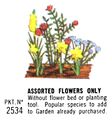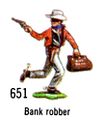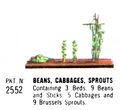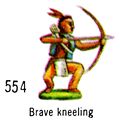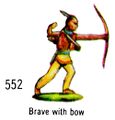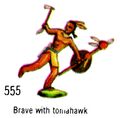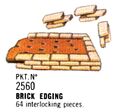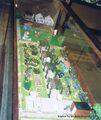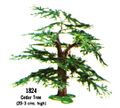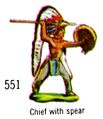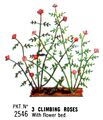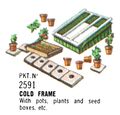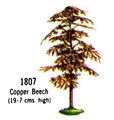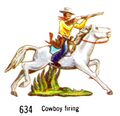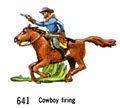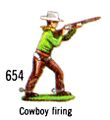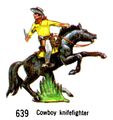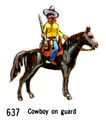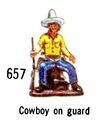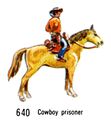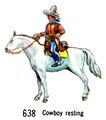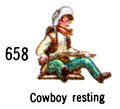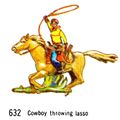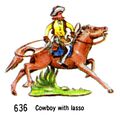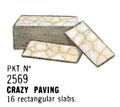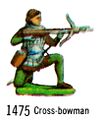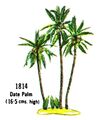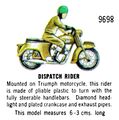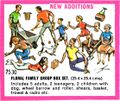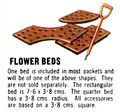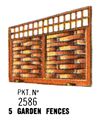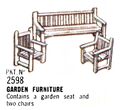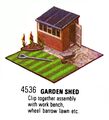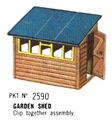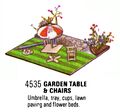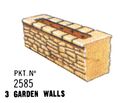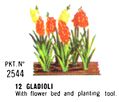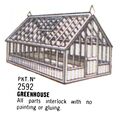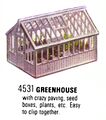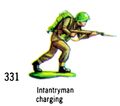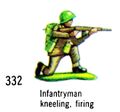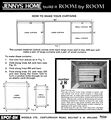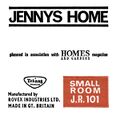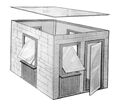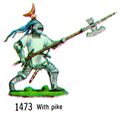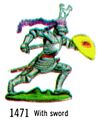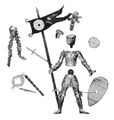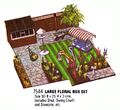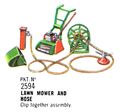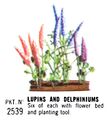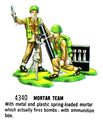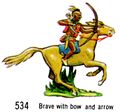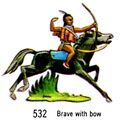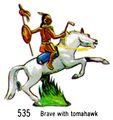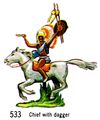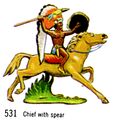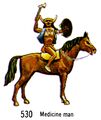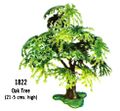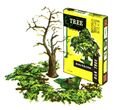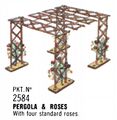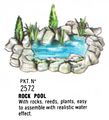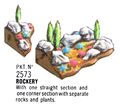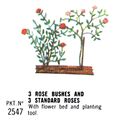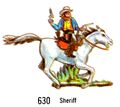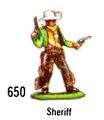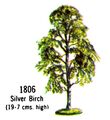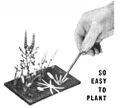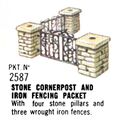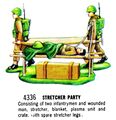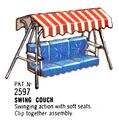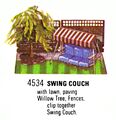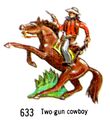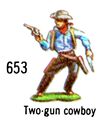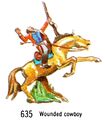Category:Plastic
Although "phenolic resin"-based materials (such as Bakelite) and impregnated composites were around in the early Twentieth Century, more modern "proper" plastics didn't really start to make a significant appearance until the 1930's, and started to have a significant impact on toymaking after World War Two (1939-1945).
Bodyshells for 00-gauge locomotives and rolling stock increasingly began to be made of injection-moulded plastic rather than diecast metal (although the chassis tended to remain metal for stability and weight), wooden metal and composite kits began being increasingly replaced by plastic kits from companies such as Airfix and Revell, and building sets , which had been characterised by a range of materials including rubber, wood and artificial stone, ended up being swept away by clip-together plastic bricks developed by Hilary Page and popularised by Lego.
Doll faces were cheaper to make in plastic than porcelain, and were more robust than wax, and the appearance of plastics solved the problem of manufacturers of small figures, who were using lead, which while a nice material to work, was beginning to be recognised as toxic and an unsuitable material for children's toys. Plastic foam was more convenient packing for soft toys such as teddybears than highly-inflammable Kapok, and was softer than "wood wool".
Industry changes
Some companies never managed to make the transition to the new post-war plastics-dominated market. Meccano Ltd. had been essentially a metal toys company, and had trouble culturally in embracing the new "cheap and nasty" material, apparently having what few plastic parts they needed in the early days of the material being contracted out, rather than developing their own in-house skills. While the Dublo range eventually started incorporating plastic bodyshells, the change came too late – Rovex Plastics (bought by Lines Brothers) had been making much cheaper plastic-shelled train sets, and while some of the Triang Railways range were initially not as nice as the quality Dublo range, and competed mainly on their lower price, plastic mouldings got to be higher and higher quality (eroding the quality differential), while Meccano Ltd couldn't reduce the price differential to match. Meccano Ltd failed and were taken over by Lines brothers who used a more diverse range of materials, but Lines failed soon after, and were mostly taken over by the Airfix Group.
The appearance of plastics didn't just create competition, it lowered the customers' general perceptions of pricing, making life more difficult for makers of metal quality toys even when they had no direct plastic-based competitors. Some toys that had previously been seen as reasonably priced for what they were started to appear rather expensive.
A textbook example of a successful way to introduce plastics into a business was produced by Arthur Katz of Mettoy. Rather than try to create a plastics department in his traditional metal toy business and have to put up with internal quarrelling, he created a separate plastic toy company, Playcraft, which initially produced some rather nasty plastic products, but steadily improved. Once Playcraft had gained enough experience of the market and processes to be semi-respectable, Katz merged Mettoy and Playcraft together, shocking Meccano Ltd by producing a range of diecast cars to compete with Dinky Toys, that had metal bodies but clear plastic windows and moulded plastic interiors. In some applications, plastic was now no longer the mark of cheap inferior products, it allowed levels of detail and sophistication that weren't previously commercially possible. Okay, so the Corgi interiors and steering wheels looked like plastic, but the Original Dinky toys didn't have interiors at all, and were simple metal shells with holes for windows, and since the interiors of some real cars were becoming more plastic and vinyl, sometimes plastics were more authentic.
External links
Subcategories
This category has the following 14 subcategories, out of 14 total.
B
- Britains Floral Garden (display) (16 P, 18 F)
H
M
- Make-Up Tree Models (Britains) (5 P, 14 F)
P
S
- Swoppet Cowboys (31 F)
- Swoppet Indians (18 F)
- Swoppet Infantry (11 F)
- Swoppet Knights (17 F)
Pages in category ‘Plastic’
The following 29 pages are in this category, out of 29 total.
B
C
G
- Garden Fences (Britains Floral Garden 2586)
- Garden Furniture (Britains Floral Garden 2598)
- Garden Roller and Wheelbarrow (Britains Floral Garden 2595)
- Garden Shed (Britains Floral Garden 2590)
- Garden Swing Couch, boxed (Britains Floral Garden 2597)
- Garden Walls (Britains Floral Garden 2585)
- Greenhouse (Britains Floral Garden 2592)
- Greenhouse, boxed (Britains Floral Garden 2592)
L
S
Media in category ‘Plastic’
The following 200 files are in this category, out of 201 total.
(previous page) (next page)- Aerial view, Britains Floral Garden display (BTMM 2021).jpg 3,000 × 781; 534 KB
- Always Buy Jennys Home Furniture, side panel, packaging (Tri-ang JR101).jpg 1,200 × 830; 128 KB
- Always Buy Jennys Home Furniture, side panel, packaging (Tri-ang JR102).jpg 1,200 × 638; 120 KB
- Apple Tree, 1801 (BritainsCat 1967).jpg 735 × 520; 75 KB
- Assorted Asters, Britains Floral Garden 2545 (Britains 1966).jpg 682 × 556; 66 KB
- Bank Robber, Britains Swoppets 631 (Britains 1967).jpg 1,419 × 1,305; 662 KB
- Bank Robber, Britains Swoppets 651 (Britains 1967).jpg 833 × 989; 235 KB
- Bench, Britains Floral Garden (BTMM 2021).jpg 1,200 × 800; 429 KB
- Block of Flats (Tri-ang Jennys Home).jpg 2,335 × 1,229; 492 KB
- Brave Kneeling, Britains Swoppets 554 (Britains 1967).jpg 860 × 860; 218 KB
- Brave with Bow, Britains Swoppets 552 (Britains 1967).jpg 996 × 1,043; 242 KB
- Brave with Tomahawk, Britains Swoppets 555 (Britains 1967).jpg 1,082 × 1,066; 281 KB
- Brick Edging, Britains Floral Garden (BTMM 2021).jpg 3,000 × 2,000; 1.27 MB
- Brick Edging, Britains Floral Garden 2560 (Britains 1966).jpg 630 × 586; 67 KB
- Britains Floral Garden display (1990s).jpg 1,516 × 1,800; 593 KB
- Britains Floral Garden, storage box 1.jpg 3,000 × 2,194; 1.29 MB
- Britains Floral Garden, storage box 2, side view.jpg 3,000 × 2,000; 745 KB
- Britains Floral Garden, storage box 2.jpg 3,000 × 2,365; 1.11 MB
- Britains Floral Garden, storage box 3.jpg 3,000 × 2,032; 1,014 KB
- Britains Floral Garden, storage box 4, end view.jpg 3,000 × 2,000; 636 KB
- Britains Floral Garden, storage box 4, side view.jpg 3,000 × 1,773; 819 KB
- Britains Floral Garden, storage box 4.jpg 3,000 × 1,998; 1.11 MB
- Britains Floral Garden, storage box 5.jpg 3,000 × 1,515; 634 KB
- Britains Folk, family group (Britains Floral Garden 7530).jpg 3,000 × 1,838; 462 KB
- Britains Folk, from above (Britains Floral Garden 7530).jpg 1,600 × 1,067; 268 KB
- British Infantry Swoppets, logo (Britains 1967).jpg 1,200 × 513; 231 KB
- Buy It Room By Room, top panel, packaging (Tri-ang JR101).jpg 2,200 × 1,489; 538 KB
- Buy It Room By Room, top panel, packaging (Tri-ang JR102).jpg 2,200 × 1,622; 638 KB
- Cedar Tree, 1824 (BritainsCat 1967).jpg 1,077 × 972; 203 KB
- Chief with Dagger, Britains Swoppets 553 (Britains 1967).jpg 796 × 1,315; 329 KB
- Chief with Spear, Britains Swoppets 551 (Britains 1967).jpg 947 × 1,098; 346 KB
- Climbing Roses, Britains Floral Garden 2546 (Britains 1966).jpg 760 × 883; 105 KB
- Coconut Palm, 1815 (BritainsCat 1967).jpg 892 × 1,203; 136 KB
- Cold Frame, Britains Floral Garden 2591 (Britains 1966).jpg 724 × 695; 82 KB
- Cold Frames, Britains Floral Garden (BTMM 2021).jpg 1,200 × 800; 490 KB
- Copper Beech Tree, 1807 (BritainsCat 1967).jpg 708 × 748; 82 KB
- Cowboy and Indian Box Set, Britains Swoppets 7630 (Britains 1967).jpg 1,200 × 953; 824 KB
- Cowboy Firing From Cover, Britains Swoppets 661 (Britains 1967).jpg 1,071 × 847; 297 KB
- Cowboy Firing, Britains Swoppets 634 (Britains 1967).jpg 1,386 × 1,340; 637 KB
- Cowboy Firing, Britains Swoppets 641 (Britains 1967).jpg 1,436 × 1,289; 548 KB
- Cowboy Firing, Britains Swoppets 654 (Britains 1967).jpg 893 × 976; 216 KB
- Cowboy Gunslinger, Britains Swoppets 656 (Britains 1967).jpg 815 × 1,065; 239 KB
- Cowboy Knifefighter, Britains Swoppets 639 (Britains 1967).jpg 1,351 × 1,431; 650 KB
- Cowboy Knifefighter, Britains Swoppets 659 (Britains 1967).jpg 772 × 1,001; 216 KB
- Cowboy On Guard, Britains Swoppets 637 (Britains 1967).jpg 1,231 × 1,394; 480 KB
- Cowboy On Guard, Britains Swoppets 657 (Britains 1967).jpg 798 × 947; 228 KB
- Cowboy Prisoner, Britains Swoppets 640 (Britains 1967).jpg 1,303 × 1,403; 479 KB
- Cowboy Prisoner, Britains Swoppets 660 (Britains 1967).jpg 780 × 1,162; 267 KB
- Cowboy Resting, Britains Swoppets 638 (Britains 1967).jpg 1,260 × 1,431; 474 KB
- Cowboy Resting, Britains Swoppets 658 (Britains 1967).jpg 786 × 713; 172 KB
- Cowboy Swoppets, logo (Britains 1967).jpg 1,200 × 517; 311 KB
- Cowboy Throwing Lasso, Britains Swoppets 632 (Britains 1967).jpg 1,505 × 1,502; 620 KB
- Cowboy With Lasso, Britains Swoppets 636 (Britains 1967).jpg 1,429 × 1,370; 694 KB
- Cowboy With Lasso, Britains Swoppets 652 (Britains 1967).jpg 860 × 1,155; 290 KB
- Cowboys Four Figure Window Box, Britains Swoppets 7620 (Britains 1967).jpg 1,200 × 700; 471 KB
- Cowboys Four Figure Window Box, Britains Swoppets 7621 (Britains 1967).jpg 1,200 × 706; 440 KB
- Cowboys Three Figure Window Box, Britains Swoppets 4656 (Britains 1967).jpg 1,283 × 971; 570 KB
- Cowboys Three Figure Window Box, Britains Swoppets 4657 (Britains 1967).jpg 1,262 × 982; 561 KB
- Crazy Paving, Britains Floral Garden 2569 (Britains 1966).jpg 572 × 512; 50 KB
- Crossbowman, Britains Swoppets 1475 (Britains 1967).jpg 827 × 976; 286 KB
- Date Palm, 1814 (BritainsCat 1967).jpg 806 × 946; 118 KB
- Dispatch Rider, Britains Swoppets 9698 (Britains 1967).jpg 1,575 × 1,590; 742 KB
- Fence, Britains Floral Garden (BTMM 2021).jpg 1,200 × 800; 490 KB
- Fir Tree, 1809 (BritainsCat 1967).jpg 757 × 963; 97 KB
- Floral Family Group set 7530 (BritainsCat 1967).jpg 1,106 × 929; 208 KB
- Floral Miniature Garden, Britains (BFGLeaflet 1960s).jpg 1,800 × 1,220; 307 KB
- Floral Miniature Garden, by Britains Ltd (BFGLeaflet 1960s).jpg 1,800 × 1,188; 372 KB
- Floral Miniature Garden, Flower Packets (Britains 1966).jpg 1,019 × 559; 94 KB
- Floral Miniature Garden, pack (Britains 1966).jpg 826 × 1,116; 162 KB
- Flower bed detail (Britains Floral Garden).jpg 3,000 × 2,000; 939 KB
- Flower Beds, Britains Floral Garden (Britains 1966).jpg 741 × 692; 98 KB
- Garden Fences, Britains Floral Garden 2586 (Britains 1966).jpg 534 × 637; 77 KB
- Garden Furniture, Britains Floral Garden 2598 (Britains 1966).jpg 705 × 647; 76 KB
- Garden Furniture, Britains Floral Garden display (BTMM 2021).jpg 1,200 × 800; 492 KB
- Garden Hose, Britains Floral Garden (BTMM 2021).jpg 1,200 × 800; 497 KB
- Garden Roller, Britains Floral Garden (BTMM 2021).jpg 1,200 × 800; 456 KB
- Garden Shed Set, Britains Floral Garden 4536 (Britains 1970).jpg 792 × 872; 95 KB
- Garden Shed, Britains Floral Garden (BTMM 2021).jpg 1,200 × 800; 542 KB
- Garden Shed, Britains Floral Garden 2590 (Britains 1966).jpg 692 × 740; 101 KB
- Garden Walls, Britains Floral Garden 2585 (Britains 1966).jpg 620 × 531; 56 KB
- Gladioli, Britains Floral Garden 2544 (Britains 1966).jpg 688 × 587; 64 KB
- Greenhouse, Britains Floral Garden (BTMM 2021).jpg 2,000 × 1,334; 1.31 MB
- Greenhouse, Britains Floral Garden 2592 (Britains 1966).jpg 780 × 748; 107 KB
- Greenhouse, Britains Floral Garden, Box Set 4531 (Britains 1970).jpg 683 × 776; 100 KB
- Hyacinths, Britains Floral Garden 2537 (Britains 1966).jpg 673 × 480; 45 KB
- Indian Swoppets, logo (Britains 1967).jpg 1,200 × 521; 290 KB
- Indians Four Figure Window Box, Britains Swoppets 7520 (Britains 1967).jpg 1,200 × 737; 502 KB
- Indians Three Figure Window Box, Britains Swoppets 4550 (Britains 1967).jpg 1,276 × 968; 572 KB
- Indians Three Figure Window Box, Britains Swoppets 4551 (Britains 1967).jpg 1,275 × 979; 548 KB
- Infantry Swoppets, exploded view (Britains 1967).jpg 1,626 × 1,960; 405 KB
- Infantryman Charging, Britains Swoppets 331 (Britains 1967).jpg 1,217 × 1,071; 273 KB
- Infantryman Kneeling, Firing, Britains Swoppets 332 (Britains 1967).jpg 1,075 × 1,004; 271 KB
- Infantryman Marching, Britains Swoppets 330 (Britains 1967).jpg 838 × 1,299; 261 KB
- Infantryman Presentation Box, Britains Swoppets 7330 (Britains 1967).jpg 1,600 × 921; 565 KB
- Infantryman Presentation Box, Britains Swoppets 7336 (Britains 1967).jpg 1,600 × 934; 661 KB
- Iron Gates, Britains Floral Garden display (BTMM 2021).jpg 3,000 × 2,000; 1.56 MB
- Jennys Home - Build it Room by Room.jpg 2,400 × 1,694; 669 KB
- Jennys Home - frame logo.jpg 2,400 × 1,311; 256 KB
- Jennys Home contents, side panel, packaging (Tri-ang JR101).jpg 2,200 × 1,509; 475 KB
- Jennys Home contents, side panel, packaging (Tri-ang JR102).jpg 2,200 × 1,164; 486 KB
- Jennys Home, 1of2 (RovexTrade 1970).jpg 1,132 × 1,600; 483 KB
- Jennys Home, 2of2 (RovexTrade 1970).jpg 1,132 × 1,600; 441 KB
- Jennys Home, by Rovex Industries (Hobbies 1967).jpg 1,600 × 876; 300 KB
- Jennys Home, curtains and carpets, Set JH9.jpg 2,211 × 2,400; 638 KB
- Jennys Home, end panels, packaging (Tri-ang JR101).jpg 1,200 × 1,186; 152 KB
- Jennys Home, end panels, packaging (Tri-ang JR102).jpg 1,200 × 853; 142 KB
- Jennys Home, Large Room, diagram (JH102).jpg 2,298 × 1,492; 595 KB
- Jennys Home, Small Room, diagram (JH101).jpg 1,572 × 1,368; 367 KB
- Junior Floral Box Set, Britains Floral Garden 7531 (Britains 1966).jpg 955 × 760; 201 KB
- Junior Floral Box Set, Britains Floral Garden 7532 (Britains 1966).jpg 954 × 1,154; 167 KB
- Junior Floral Box Set, Britains Floral Garden 7533 (Britains 1966).jpg 1,289 × 722; 161 KB
- Knight on Foot, with Axe, Britains Swoppets 1474 (Britains 1967).jpg 957 × 1,259; 432 KB
- Knight on Foot, with Lance, Britains Swoppets 1470 (Britains 1967).jpg 1,028 × 1,749; 574 KB
- Knight on Foot, with Pike, Britains Swoppets 1473 (Britains 1967).jpg 1,362 × 1,296; 465 KB
- Knight on Foot, with Sword, Britains Swoppets 1471 (Britains 1967).jpg 1,004 × 1,200; 452 KB
- Knight Swoppets, exploded view (Britains 1967).jpg 2,024 × 2,139; 761 KB
- Knight Swoppets, logo (Britains 1967).jpg 1,200 × 529; 257 KB
- Large Floral Box Set, Britains Floral Garden 7543 (Britains 1970).jpg 1,752 × 1,161; 293 KB
- Large Floral Box Set, Britains Floral Garden 7544 (Britains 1970).jpg 1,310 × 1,205; 242 KB
- Large Floral Box Set, Britains Floral Garden 7545 (Britains 1966).jpg 1,563 × 1,037; 265 KB
- Large Floral Box Set, Britains Floral Garden 7546 (Britains 1966).jpg 1,517 × 1,089; 271 KB
- Lawn Mower and Hose, Britains Floral Garden 2594 (Britains 1966).jpg 853 × 798; 86 KB
- Lawn, Britains Floral Garden 2568 (Britains 1966).jpg 870 × 671; 70 KB
- Longbowman, Britains Swoppets 1472 (Britains 1967).jpg 958 × 1,368; 399 KB
- Lucys Garden Packs, Britains 7182 (BritCat 1978).jpg 940 × 1,200; 246 KB
- Lucys Little Garden Pack, Britains 7180 (BritCat 1978).jpg 2,096 × 1,247; 538 KB
- Make-up Tree Models, Britains (BFGLeaflet 1960s).jpg 1,800 × 1,188; 327 KB
- Make-Up Tree Models, logo (BritainsCat 1967).jpg 916 × 464; 90 KB
- Medicine Man, Britains Swoppets 550 (Britains 1967).jpg 787 × 1,064; 243 KB
- Medium Floral Box Set, Britains Floral Garden 7534 (Britains 1970).jpg 1,380 × 759; 147 KB
- Medium Floral Box Set, Britains Floral Garden 7535 (Britains 1970).jpg 1,362 × 876; 158 KB
- Medium Floral Box Set, Britains Floral Garden 7536 (Britains 1966).jpg 1,288 × 1,065; 236 KB
- Medium Floral Box Set, Britains Floral Garden 7537 (Britains 1966).jpg 1,361 × 867; 216 KB
- Medium Floral Box Set, Britains Floral Garden 7538 (Britains 1966).jpg 1,435 × 1,055; 234 KB
- Mortar Team, Britains Swoppets 4340 (Britains 1967).jpg 1,633 × 1,901; 979 KB
- Mounted Indian, Brave with Bow and Arrow, Britains Swoppets 534 (Britains 1967).jpg 1,365 × 1,274; 555 KB
- Mounted Indian, Brave with Bow, Britains Swoppets 532 (Britains 1967).jpg 1,297 × 1,302; 569 KB
- Mounted Indian, Brave with Tomahawk, Britains Swoppets 535 (Britains 1967).jpg 1,319 × 1,395; 594 KB
- Mounted Indian, Chief with Dagger, Britains Swoppets 533 (Britains 1967).jpg 1,367 × 1,636; 665 KB
- Mounted Indian, Chief with Spear, Britains Swoppets 531 (Britains 1967).jpg 1,373 × 1,464; 780 KB
- Mounted Indian, Medicine Man, Britains Swoppets 530 (Britains 1967).jpg 1,294 × 1,534; 579 KB
- Mounted Knight, Attacking, Britains Swoppets 1452 (Britains 1967).jpg 1,049 × 1,456; 532 KB
- Mounted Knight, Charging, Britains Swoppets 1451 (Britains 1967).jpg 1,126 × 1,396; 601 KB
- Mounted Knight, Defending, Britains Swoppets 1453 (Britains 1967).jpg 1,134 × 1,471; 598 KB
- Mounted Knight, with Standard, Britains Swoppets 1450 (Britains 1967).jpg 1,506 × 1,907; 666 KB
- Oak Tree, 1822 (BritainsCat 1967).jpg 979 × 904; 186 KB
- Oak Tree, unassembled, 1822 (BritainsCat 1967).jpg 1,439 × 1,316; 377 KB
- One-room Bungalow (Tri-ang Jennys Home).jpg 1,487 × 1,001; 258 KB
- Penthouse Bungalow (Tri-ang Jennys Home).jpg 1,637 × 1,256; 289 KB
- Pergola and Roses, Britains Floral Garden 2584 (Britains 1966).jpg 707 × 723; 82 KB
- Pergola, Britains Floral Garden (BTMM 2021).jpg 3,000 × 2,000; 1.26 MB
- Planting Tool (Britains Floral Garden).jpg 2,000 × 665; 68 KB
- Planting, Pond, Britains Floral Garden (BTMM 2021).jpg 3,000 × 2,000; 1.31 MB
- Planting, The Floral Miniature Garden Series, Britains (BFGLeaflet 1960s).jpg 1,800 × 915; 270 KB
- Poplar Tree, 1820 (BritainsCat 1967).jpg 720 × 1,312; 126 KB
- Rhododendron Bushes, Britains Floral Garden 2543 (Britains 1966).jpg 701 × 559; 75 KB
- Rock Pool, Britains Floral Garden 2572 (Britains 1966).jpg 779 × 857; 107 KB
- Rock Pool, Britains Floral Garden, Box Set 4533 (Britains 1970).jpg 866 × 706; 75 KB
- Rockery, Britains Floral Garden (BTMM 2021).jpg 2,400 × 1,600; 1.83 MB
- Rockery, Britains Floral Garden 2573 (Britains 1966).jpg 813 × 726; 93 KB
- Rockery, Britains Floral Garden, Box Set 4532 (Britains 1970).jpg 877 × 637; 81 KB
- Scots Pine Tree, 1810 (BritainsCat 1967).jpg 662 × 943; 84 KB
- Sheriff, Britains Swoppets 630 (Britains 1967).jpg 1,461 × 1,302; 578 KB
- Sheriff, Britains Swoppets 650 (Britains 1967).jpg 862 × 992; 228 KB
- Silver Birch Tree, 1806 (BritainsCat 1967).jpg 684 × 749; 94 KB
- Six-Room Bungalow (Tri-ang Jennys Home).jpg 1,911 × 1,307; 412 KB
- Small and Large Rooms, JR101 and JR102, Jennys Home (Hobbies 1967).jpg 1,600 × 1,012; 293 KB
- So Easy to Plant, Britains Floral Garden (Britains 1966).jpg 996 × 899; 106 KB
- Stone Wall corner, Britains Floral Garden display (BTMM 2021).jpg 1,600 × 1,067; 701 KB
- Stone Wall, Britains Floral Garden (BTMM 2021).jpg 3,000 × 2,000; 931 KB
- Stretcher Party, Britains Swoppets 4336 (Britains 1967).jpg 1,853 × 1,916; 1.29 MB
- Sunflowers and Hollyhocks, Britains Floral Garden 2542 (Britains 1966).jpg 765 × 1,083; 107 KB
- Sunflowers, Britains Floral Garden (BTMM 2021).jpg 1,200 × 800; 524 KB
- Swing Couch, Britains Floral Garden 2597 (Britains 1966).jpg 742 × 750; 100 KB
- Swing Couch, Britains Floral Garden, Box Set 4534 (Britains 1970).jpg 792 × 816; 114 KB
- Swoppet Cowboy Boxed Set, Britains Swoppets 7627 (Britains 1967).jpg 1,600 × 920; 962 KB
- Swoppet Indian Box Set, Britains Swoppets 7527 (Britains 1967).jpg 1,200 × 677; 605 KB
- Swoppet Knight Boxed Set, Britains Swoppets 7481 (Britains 1967).jpg 2,000 × 917; 1.17 MB
- Swoppet Knights, Five Figure Window Box 7470 (Britains 1967).jpg 1,600 × 931; 876 KB
- Swoppet Knights, Four Figure Window Box 7475 (Britains 1967).jpg 1,600 × 909; 884 KB
- Swoppet Knights, Three Figure Window Box 4470 (Britains 1967).jpg 1,200 × 917; 575 KB
- Swoppet Knights, Three Figure Window Box 4473 (Britains 1967).jpg 1,200 × 920; 542 KB
- Three-Figure Window Box Sets, Britains Swoppets 4330 (Britains 1967).jpg 1,200 × 912; 456 KB
- Three-room Bungalow (Tri-ang Jennys Home).jpg 1,741 × 1,004; 305 KB
- Tools, Britains Floral Garden (BTMM 2021).jpg 3,000 × 2,000; 942 KB
- Two-Gun Cowboy, Britains Swoppets 633 (Britains 1967).jpg 1,220 × 1,329; 607 KB
- Two-Gun Cowboy, Britains Swoppets 653 (Britains 1967).jpg 763 × 863; 212 KB
- Two-Room Bedsitter (Tri-ang Jennys Home).jpg 1,712 × 992; 289 KB
- Weeping Willow, Britains Floral Garden 2600 (Britains 1966).jpg 592 × 857; 77 KB
- Wounded Cowboy, Britains Swoppets 635 (Britains 1967).jpg 1,341 × 1,536; 626 KB




